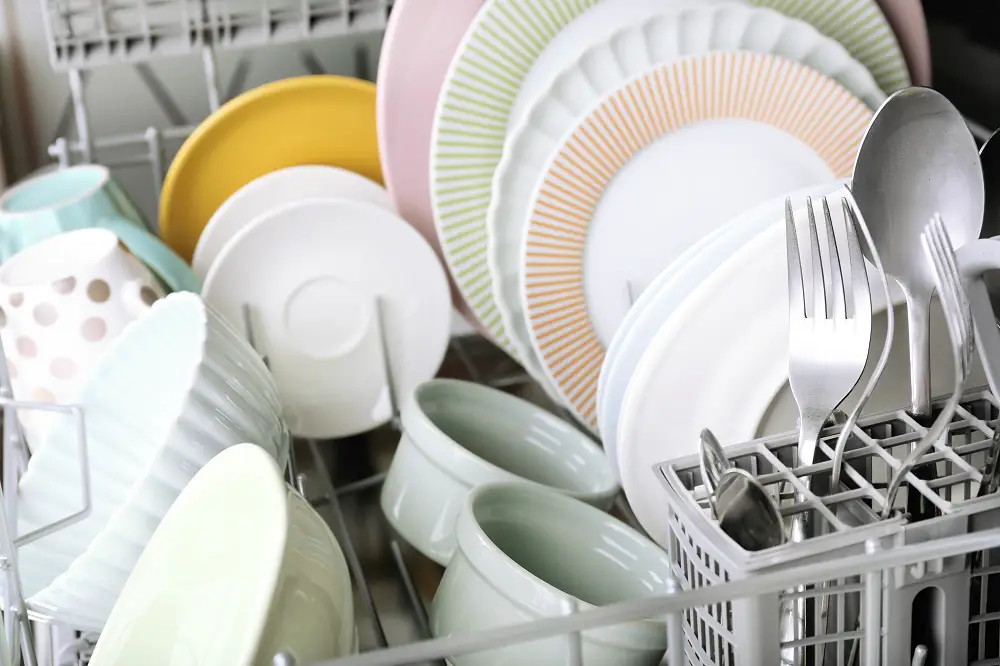With dishwashers (built-in, portable, or countertop dishwashers), the task of washing dishes is undoubtedly made convenient and efficient. But what are the differences between built-in dishwashers and portable dishwashers?
Built-in dishwashers are permanently installed, larger in size, and do cost more. They are the best choice for spacy kitchens and big dish loads. Portables are smaller, and have to be set up each time, but can be stored away. They are ideal if tight on space and for small loads.
The concrete differences between these dishwashers lie in some factors including cost, energy and water consumption, flexibility, and noise levels.
We have rated the important factors in a single table.
Table of Contents
Comparison of Built-In and Portable Dishwashers
The several factors that can be used to compare portable dishwashers with built-in dishwashers:
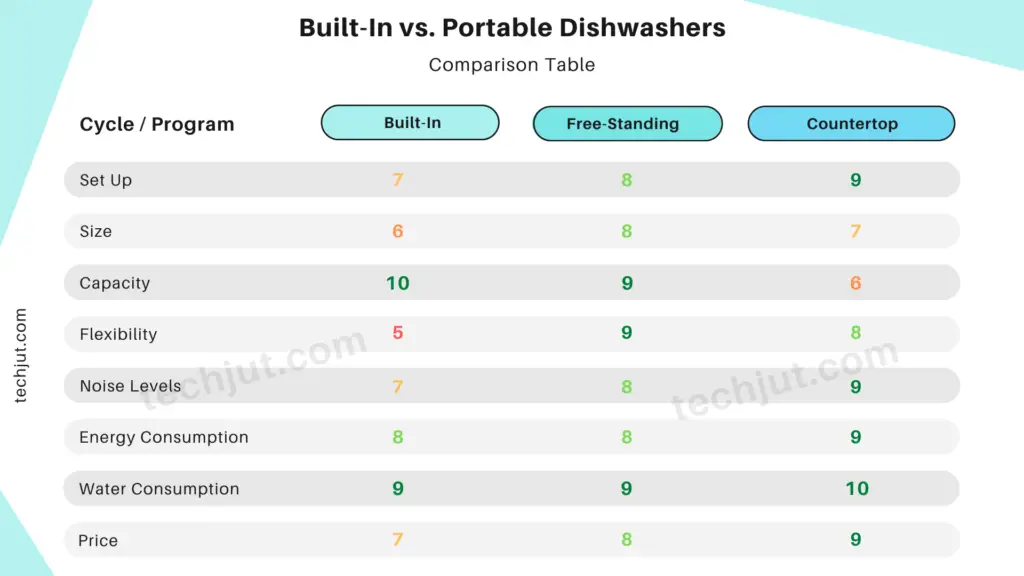
Here’s how the factors vary between built-in and portable dishwashers.
Set-Up
A built-in dishwasher holds a permanent spot in your kitchen. It is designed to be installed underneath a kitchen countertop. The setup of a built-in dishwasher involves a one-time connection to your home’s plumbing.
While you can easily install one in a new kitchen, you might need partial renovation in an existing kitchen, involving the provision of a power outlet, the extension of plumbing lines of the kitchen sink, and the removal of a few drawers or base cabinets to accommodate the dishwasher.
Portable dishwashers make for a temporary fixture and don’t require any special installation.
Although, you don’t have to dedicate a space for setup.
Every time you use a portable dishwasher, you’ll have to connect it to the water source and set up the drain hose to drain directly into the sink.
Concerned about draining? You’ll be relieved after reading our article about how to drain a portable dishwasher.
Size
A standard built-in dishwasher is 24″ wide and takes up space in your kitchen permanently.
Portable freestanding dishwashers come in 18″ or 24″ widths (with a 24″ capacity almost similar to a built-in dishwasher’s) and can be wheeled around into storage or a corner in between uses.
Countertop dishwashers are 16″ – 22″ wide and occupy counter space. You can move them around, but the position is usually permanent.
Capacity
Built-ins typically have 12 – 16 place settings.
Most freestanding dishwashers are 18″ wide and hold about 8 – 10 place settings. However, 24″ portable dishwashers are also available and are more common these days. Their load capacity is similar to a built-in dishwasher, with up to 16 place settings.
Countertop models usually have a six-place settings capacity. They are very limited and this concern is one of the most important aspects when buying a portable dishwasher.
Costs (Purchase)
Often, with multi-functionality and many different wash cycles, built-in dishwashers are slightly more expensive than portable devices. The installation costs also add to the expenses.
Built-in dishwashers typically cost between $300 – $1,000.
While countertop dishwashers usually cost about $200 – $600, the freestanding ones cost between $400 – $700.
These numbers are only a rough estimate and you should consider some more details before choosing a portable. Our article about portable dishwasher will help you to find out when they are worth it.
Energy Consumption
A built-in dishwasher uses approximately 249 – 270 kWh per year.
Countertop dishwashers use about 120 – 250 kWh per year, and the Energy-Star-rated freestanding models use about 270 kWh per year.
The energy consumption of portable dishwashers and regulars is almost the same.
The main reason for the lower energy usage is the limited capacity. Smaller devices don’t need to heat up as much and use less energy per cycle.
Water Consumption
Countertop dishwashers use as little as two gallons per load, while portable freestanding and built-in dishwashers may use about 3 – 4 gallons per load.
This is also a result of the reduced capacity of a countertop dishwasher. With less amount of dishware, you don’t need much water to clean it.
Nevertheless, since handwashing uses up to 27 gallons of water, any dishwasher is a better option.
Flexibility
Since built-in dishwashers are permanently fixed, they aren’t flexible.
The portable ones can be moved around, and there’s flexibility on where you can place a portable appliance, provided you can connect to a power supply, water source, and drain appropriately.
Noise Levels
Typical built-in dishwashers have a noise level of 38 – 66 dBA, while the quieter portable freestanding ones have a decibel rating of about 50 – 55 dBA (as loud as a microwave).
Countertop dishwashers have a noise level of about 34 – 58 dBA.
The noise level depends mainly on the model and not so much on the type. If you prefer a silent dishwasher, you should check the specs of your desired model (like the built-in Kitchenaid) in detail.
When To Buy A Built-In Dishwasher
You should opt for a built-in model only if you can accommodate one with the space and water lines required.
A built-in dishwasher is appropriate if you have a a lot of tableware to wash or use bigger dishes (including pots and pans).
Built-In
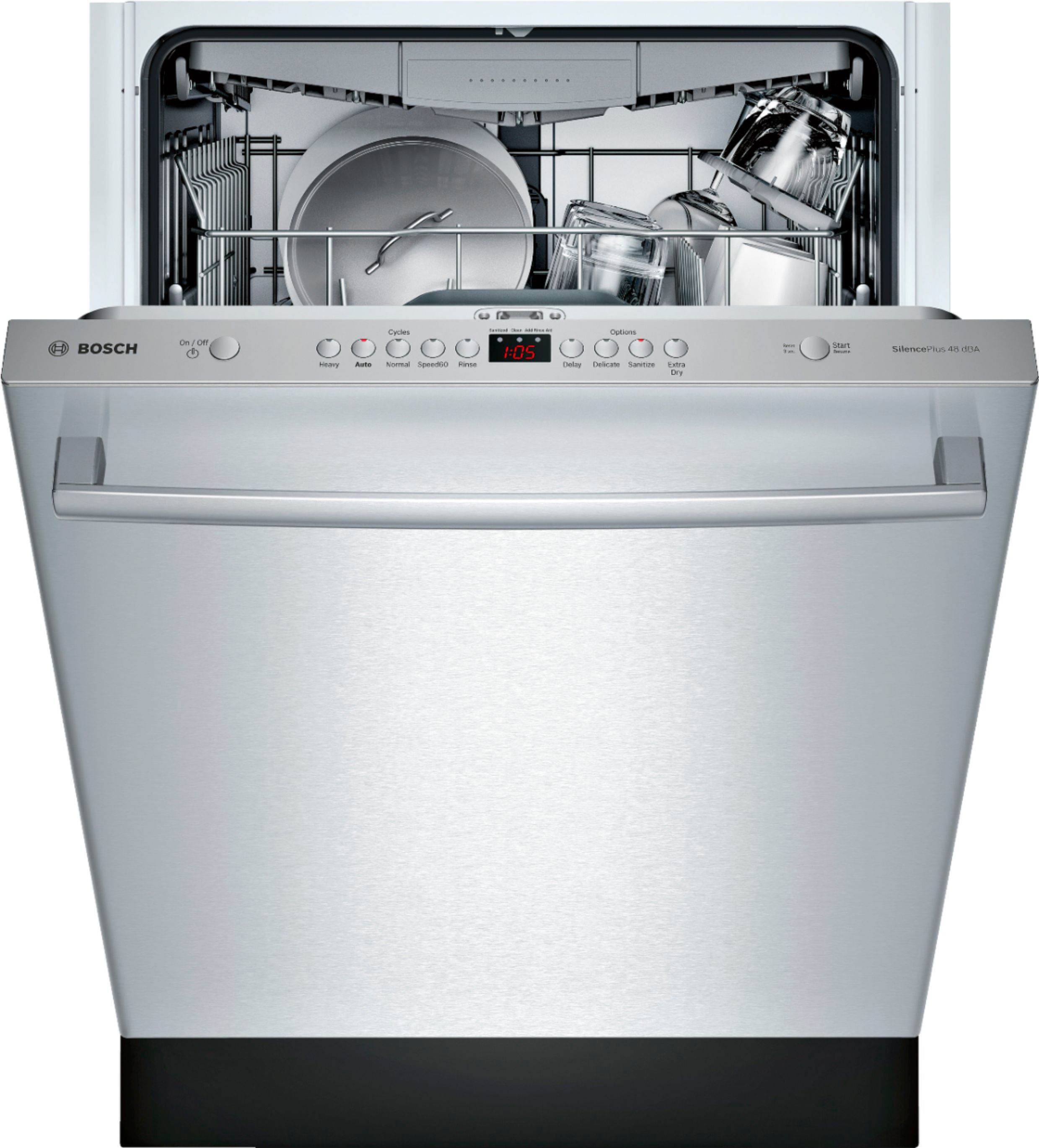
This exceptionally quiet dishwasher features six wash cycles, an adjustable upper rack, and 14-place settings.
With a 50 dBA rating, it uses 18 unique sound-reducing technologies for a remarkably quiet operation.
Its triple filtration system eliminates the need for deep pre-rinsing, and with Energy-Star-certified efficiency, it helps save energy and water.
The delay start lets you set your dishwasher to run with a delay of three, six, or nine hours.
At 1400 W, the estimated annual energy use is 269 kWh, and the annual energy cost to run this dishwasher amounts to about $33.
Price: from $899
Built-In
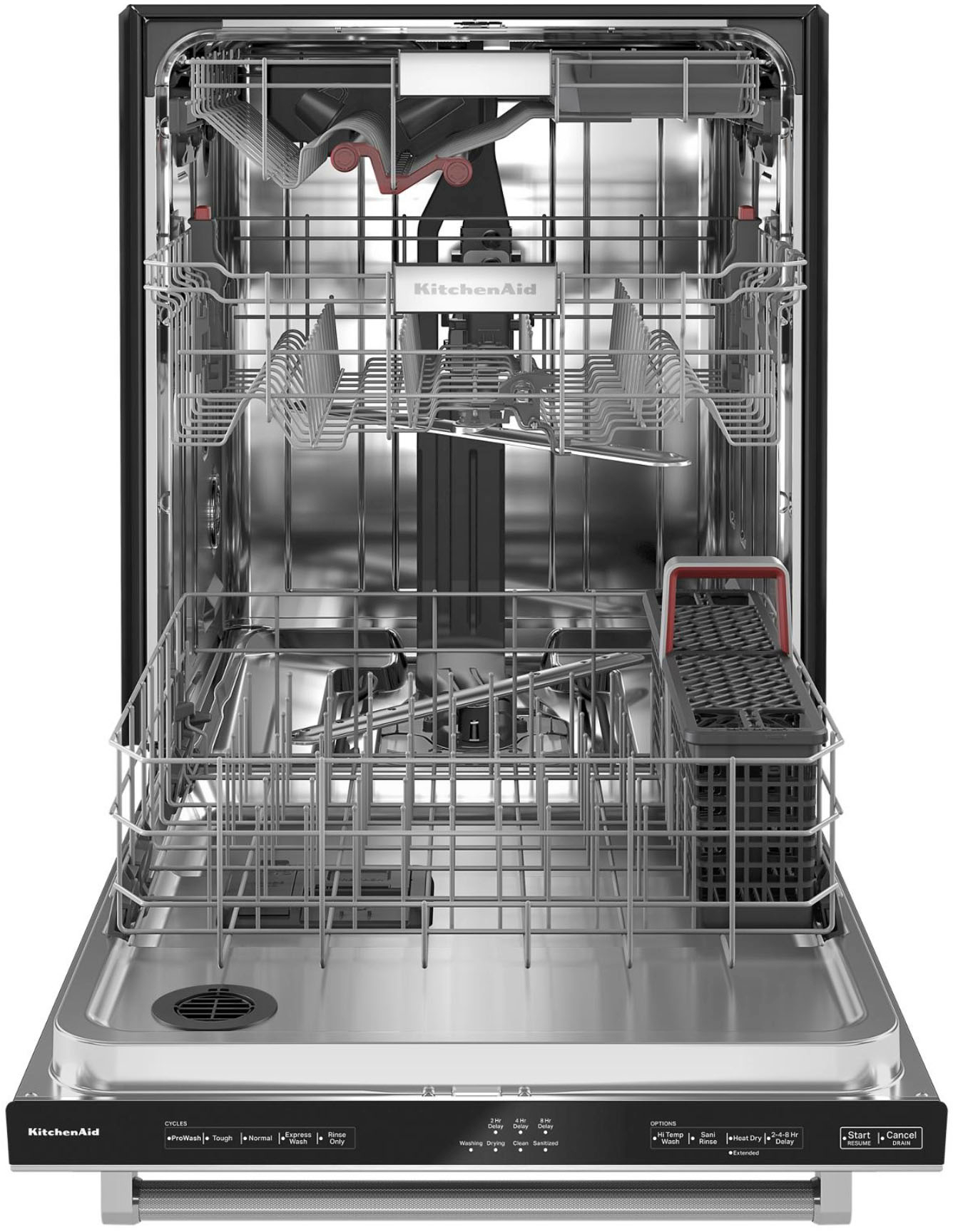
For a compact and convenient appliance, this countertop dishwasher, with a six-ounce capacity, is a great choice.
With six-place settings, it also includes a cutlery basket and folding-down rack shelves. It has seven washing programs to provide a full-size dishwasher-like cleaning. The accessories and faucet adapter makes for easy and quick installation.
A 45-minute speed wash cycle, an extra drying function that adds extra heat to the final rinse, and self-cleaning are some of the additional features of this portable kitchen appliance.
For those living in small apartments or dorm rooms or traveling often in a camper or RV, this 680 W countertop dishwasher is a convenient option.
Price: from $999
When To Buy A Portable Dishwasher
When there is no space underneath your kitchen counter, or you can’t make provisions for piping water to a new dishwasher, a portable model is the next best option to consider.
Although portable and countertop dishwashers are both temporary fixtures to a kitchen sink, the difference is that a freestanding dishwasher can be rolled away into a storage space or a corner when not in use, while a countertop dishwasher occupies counter space.
While the water inlet is through the kitchen faucet, a portable dishwasher drain line must also be set up to drain the dirty water into the sink.
Additionally, for a less expensive option and hassle-free installation without changing your kitchen cabinets or plumbing, if you’re staying alone, a small family of two, or you’re often on the move, opt for a portable dishwasher.
Countertop

For a compact and convenient appliance, this countertop dishwasher, with a six-ounce capacity, is a great choice.
With six-place settings, it also includes a cutlery basket and folding-down rack shelves.
It has seven washing programs to provide a full-size dishwasher-like cleaning.
The accessories and faucet adapter makes for easy and quick installation.
A 45-minute speed wash cycle, an extra drying function that adds extra heat to the final rinse, and self-cleaning are some of the additional features of this portable kitchen appliance.
For those living in small apartments or dorm rooms or traveling often in a camper or RV, this 680 W countertop dishwasher is a convenient option.
Price: from $299
Free-Standing
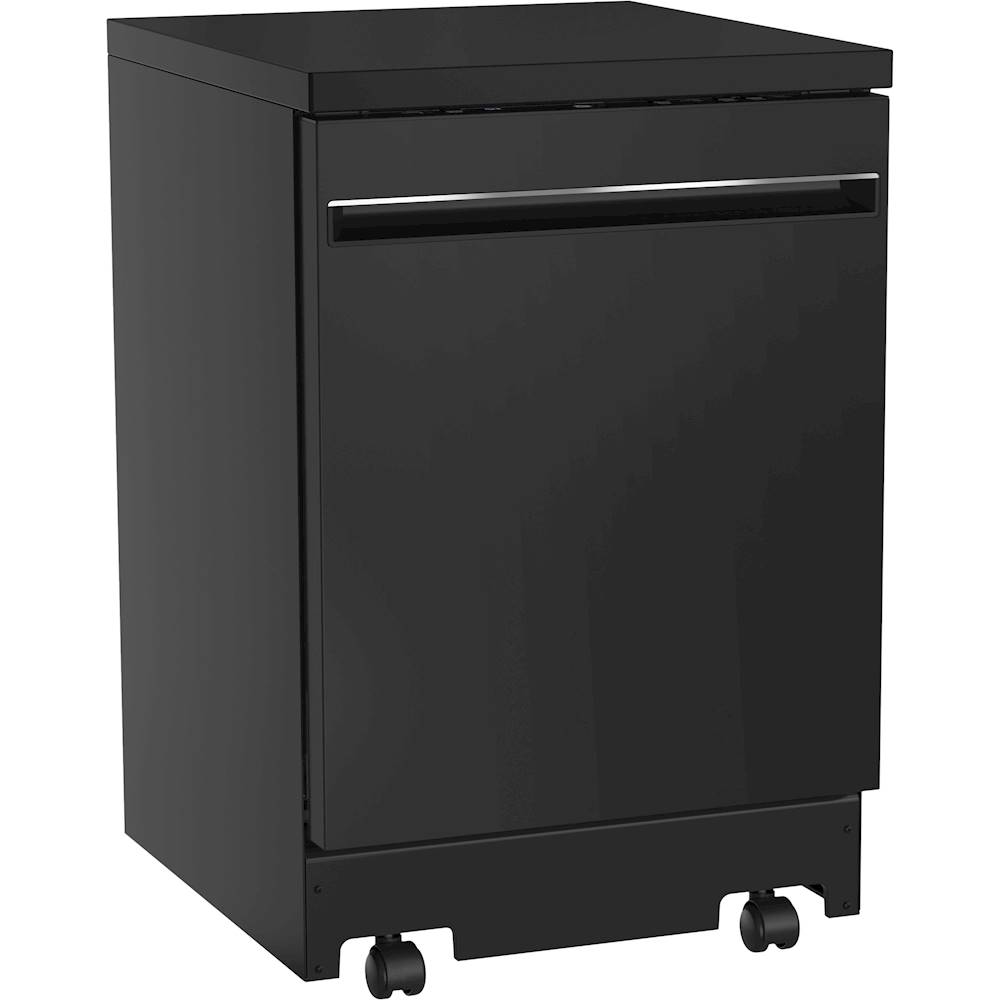
With three wash cycles (Light Wash, Heavy Wash, and Auto Sense), 12 place settings, and a delay start function for up to 12 hours, this portable freestanding dishwasher is almost as good as a built-in model.
Its unique feature includes a Piranha hard food disposer apart from an Auto Sense cycle feature that adjusts the ideal cycle time based on the soil level of the dishes and water temperature.
The Sanitize option uses a high-temperature rinse to sanitize and eliminate 99.9% of bacteria on the dishes.
This Energy-Star-certified appliance also works with Google Assistant and Amazon Alexa and operates at 54 dBA noise levels.
Price: from $630
Conclusion
Apart from the convenience of any dishwasher, the difference between built-in dishwashers and portable dishwashers mainly lies in multiple factors.
From the set-up, capacity, size, and cost to the energy and water consumption, noise, and flexibility of use, each dishwasher type also has its pros and cons.
If you’re considering purchasing a new dishwasher, check these factors to decide which suits your needs the best.
